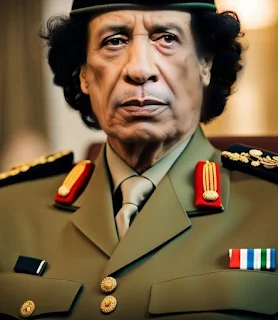Colonel Muammar Gaddafi and the Aouzou Strip
Former Libyan President Colonel Muammar Gaddafi occupied the Aouzou Strip, providing a strategic foothold in Chad. The Aouzou Strip, 62 miles wide and 62 miles long, runs parallel to Libya's southern border and was initially occupied by Libya in 1975 and annexed in 1976. It contains valuable minerals, including uranium.
Libya and the Aouzou Strip
In 1973, Libya, under the leadership of Colonel Muammar Gaddafi, occupied the Aouzou Strip, a narrow strip of territory in northern Chad. This occupation served several strategic purposes for Libya. First, the Aouzou Strip was considered strategically important due to its proximity to Chad, providing Libya with a foothold in this neighboring country. Second, the strip was believed to contain valuable mineral resources, including uranium, further enhancing its significance.
By establishing control over the Aouzou Strip, Libya aimed to extend its influence and assert its interests in Chad. This move was part of Gaddafi's broader strategy to exert influence in the region and promote his vision of a unified Arab and African world. The occupation of the Aouzou Strip marked the beginning of Libya's involvement in Chadian affairs, leading to a prolonged period of political and military engagement in Chad, including support for Chadian rebel groups and proxy conflicts.
 |
| Colonel Muammar Gaddafi |
Colonel Muammar Gaddafi and Northern Chad
Colonel Muammar Gaddafi, the leader of Libya, provided support to northern Chadian dissidents during the Chadian civil war in the late 1970s. This support was part of his broader efforts to exert influence in Chad, given its geographical proximity to Libya and shared tribal and religious affinities between northern Chad and southern Libya.
One of the key figures he supported was Goukouni Oueddei, the leader of the Tebu people and a prominent northern Chadian rebel. With Libyan assistance, including equipment and troops, Goukouni Oueddei's forces managed to capture N'Djamena, the capital of Chad, in December 1980.
However, Gaddafi and Goukouni Oueddei's proposal for a merger between Libya and Chad faced significant opposition on the international stage. West African states and France, Chad's former colonial power, strongly objected to the idea. They viewed Libya's expanding influence in Chad as threatening regional stability and sovereignty. Additionally, within Goukouni's own forces, there was opposition to Libya's presence and tactics.
Under relentless international pressure, Libya withdrew an estimated 10,000 to 15,000 troops from Chad to the Aouzou Strip in November 1981, significantly reducing its direct involvement in Chadian affairs. This move left Hissein Habré, a rival to Goukouni Oueddei, in control of N'Djamena. Habré continued to press for Libya's withdrawal from the Aouzou Strip, a contentious border area, as the Chadian civil conflict continued.
Ownership of the Aouzou Strip
Ownership of the Aouzou Strip was contested by the two countries beginning in 1973. Following the resumption of diplomatic relations between them on October 3, 1988, both States proclaimed their willingness to resolve the dispute over the Strip by peaceful means.
On August 31, 1989, the two Governments signed, in Algiers, a Framework Agreement on the Peaceful Settlement of the Territorial Dispute. In September 1990, after several rounds of inconclusive talks, Chad and the Libyan Arab Jamahiriya referred the dispute to the International Court of Justice (ICJ).
In its Judgment, delivered on February 3, 1994, the ICJ found that the boundary between Chad and the Libyan Arab Jamahiriya had been defined by the Treaty of Friendship and Good-Neighbourliness. The ICJ ruled in favor of Chad, stating that the Aouzou Strip belonged to Chad and not Libya. In March 1994, both Governments pledged to abide by the ICJ Judgment. After further talks, an agreement was signed on April 4, 1994, establishing the procedures for implementing the Judgment.
Colonel Muammar Gaddafi's Death
Colonel Muammar Gaddafi, who had been in power since 1969, was killed on October 20, 2011. He was captured and killed by anti-Gaddafi forces, including rebel groups and Western and Arab countries, during the Libyan Civil War that year. Gaddafi's death marked the end of his more than four-decade-long rule in Libya.
The National Transitional Council (NTC), the political leadership of the anti-Gaddafi forces, initially reported that Gaddafi had been killed in the crossfire during a battle in Sirte, but how Gaddafi died remains a controversial subject.
Did you know?
In 1975, Gaddafi occupied the Aouzou Strip, which is a 62-mile wide and 62-mile-long region in Chad, providing him with a strategic foothold.




